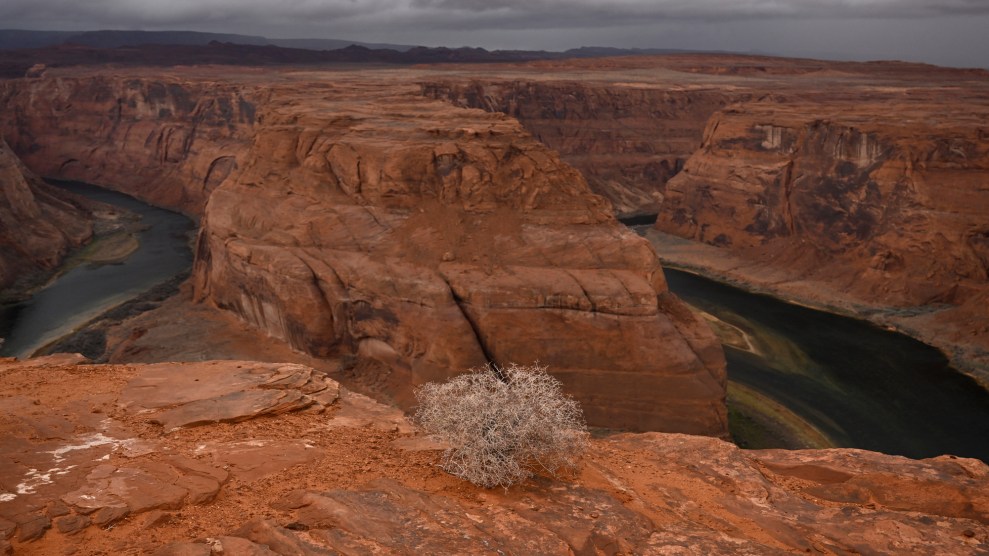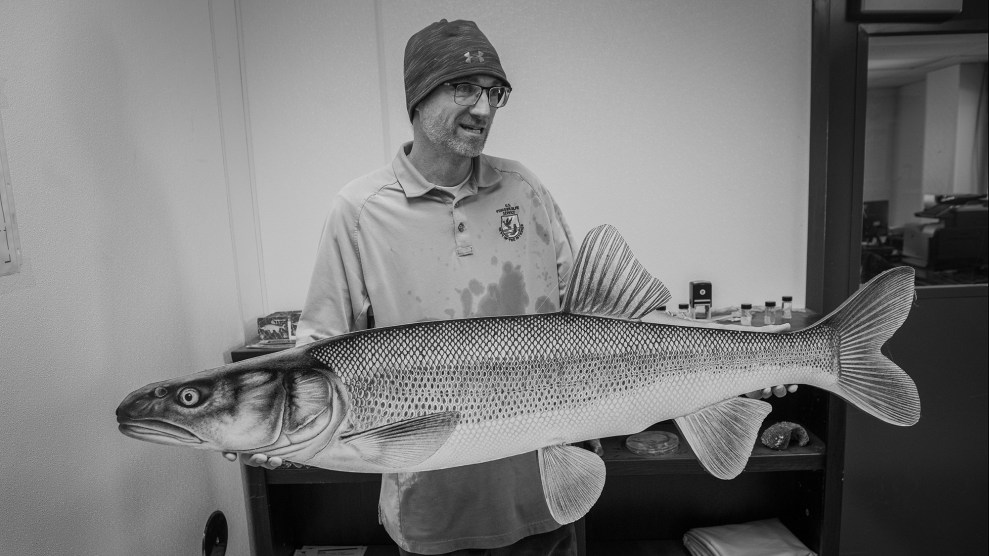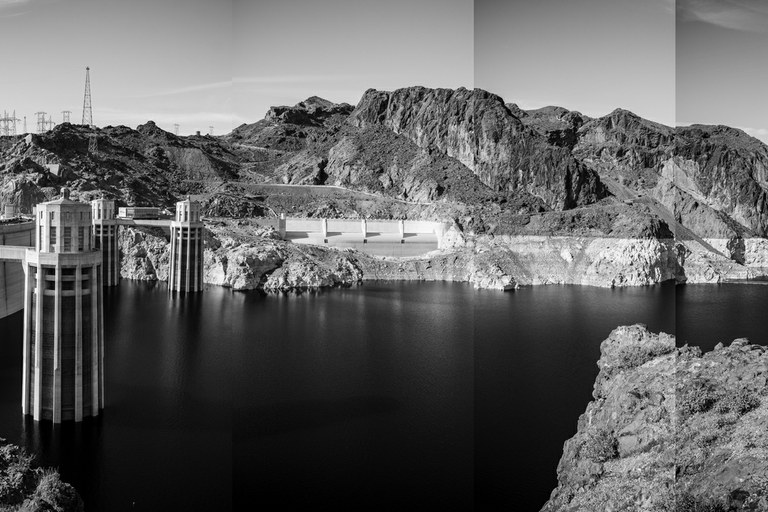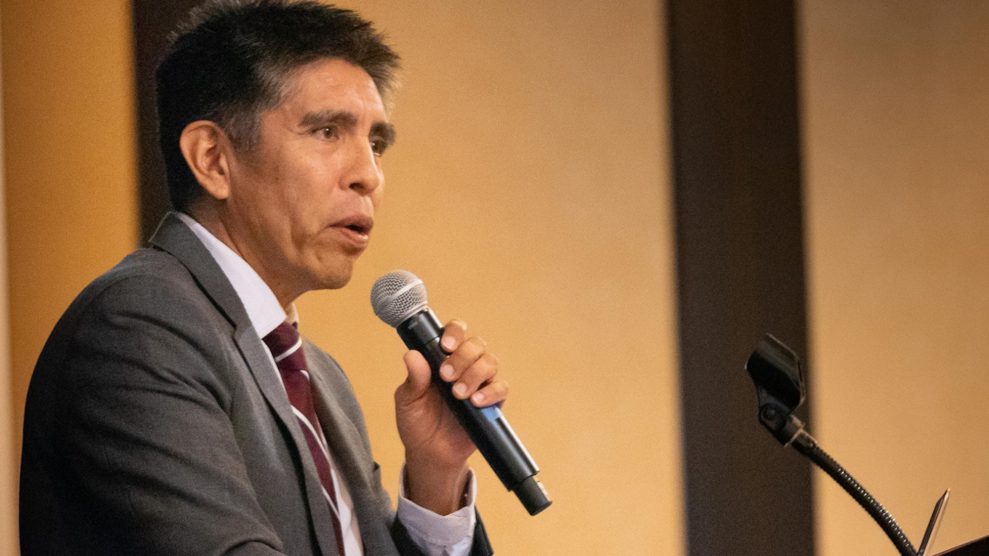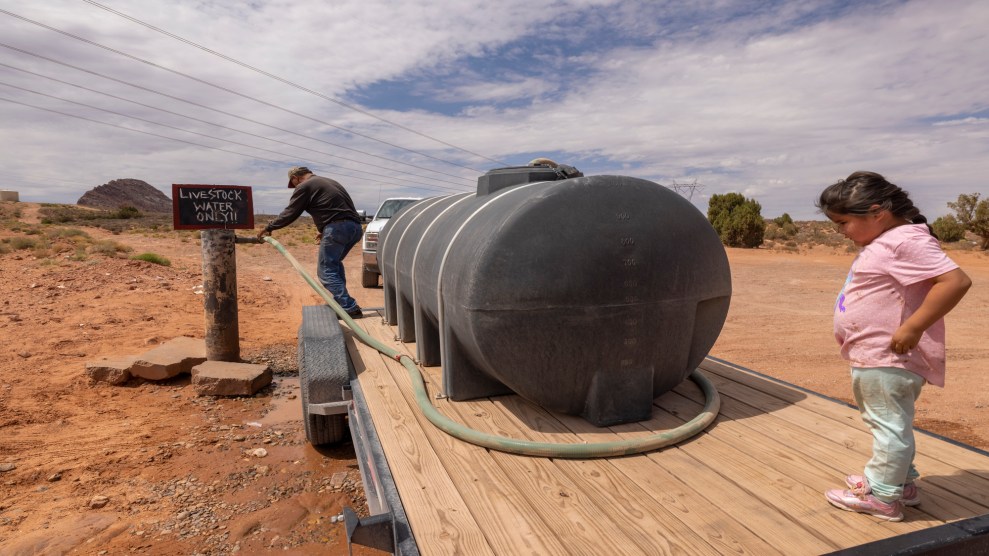
A man fills a tank intended for drought-affected livestock from a community rancher's well on the Navajo Nation. David McNew/Getty
This story was originally published by Grist and is reproduced here as part of the Climate Desk collaboration.
In 1849 and 1868, the Navajo Nation signed two treaties with the United States. The treaties created a reservation that would serve as a “permanent home” for the Navajo so long as the tribe allowed settlers to live on most of its traditional territory, which include much of what is currently New Mexico, Arizona, Utah, and Colorado. The treaties also established that the government would provide the Navajo with “seeds and agricultural implements” to raise crops on the reservation.
After 20 years of litigation, representatives for the Navajo Nation appeared before the Supreme Court on Monday to argue that those treaties require the federal government to provide water to their reservation, likely from the much-contested Colorado River. On the opposing side were lawyers for the Biden administration and a group of western states, who argued that a decision in favor of the Navajo Nation would upend the legal landscape around the Colorado River at a time when states are already scrambling to cope with drought. The outcome of the case could determine the future of water access on the Navajo reservation.
“If the Supreme Court agrees with the Biden administration that there’s no judicially enforceable obligation to do anything with water, that would be a seriously consequential and very damaging decision,” said Jay Weiner, water counsel for the Quechan Indian Tribe of the Fort Yuma Indian Reservation.
The two-hour argument session in Arizona v. Navajo Nation hinged on several questions that appeared to divide the nine-member court down the middle, leaving the scope and direction of the justices’ final decisions unclear. If the Navajo win, they will have a narrow but workable path to secure a significant water settlement on the Colorado River, but if they lose, their litigation over the river will come to an end, forcing them to look elsewhere for a solution to decades of water access problems.
The Navajo reservation straddles New Mexico, Arizona, and Utah, and a large part of the territory, which is roughly the size of West Virginia, borders the Colorado River. But the Navajo Nation doesn’t have rights to take water from the river. The tribe can pump groundwater and take some water from the river’s tributaries, but it lacks the infrastructure to provide water to its citizens, and as a result, many parts of the reservation face serious water access issues. Many tribal citizens rely on deliveries of bottled water for basic health needs and use, on average, seven gallons of water per day—around one-twentieth of the daily amount that residents of neighboring Arizona use.
“For the better part of a century and a half, development in the west has historically and systemically underfunded and disregarded tribal nations,” Weiner said. “Billions of dollars for infrastructure projects of all kinds have gone to off-reservation communities at the expense of marginalized tribes. “
The question before the Supreme Court on Monday was whether the United States’s treaties with the Navajo Nation requires it to find more water for the tribe. The Court ruled in a landmark 1908 case called Winters that when the government creates an Indian reservation, it accepts an obligation to deliver water to that reservation for agricultural use. The Navajo argue that the government has failed to meet that obligation. While the tribe has limited access to water from a few Colorado River tributaries, much of the reservation borders the Colorado River’s main stem, and the tribe argues that it should have rights to use that water.
At least four justices seemed to find the Navajo Nation’s argument persuasive. Justice Neil Gorsuch, who often sides with his three liberal colleagues on Indigenous issues, pressed the government’s lawyer, Frederick Liu on the question of the government’s obligations.
“Clearly there is a duty to provide some water to this tribe under the treaty right now,” he said to Liu. “What am I missing?” The court’s three liberal justices echoed Gorsuch’s line of reasoning about the treaty, as did conservative Amy Coney Barrett, indicating a potential majority in the Navajo’s favor.
The problem for the Navajo Nation is that if the United States meets the obligations of Winters, the delivery of water to Navajo citizens would clash with other realms of water law. Since the Supreme Court already allocated all the water in the lower Colorado River decades ago, fulfilling the Navajo Nation’s treaty rights might require it to take water away from one or more of the seven states that use the river.
In an amicus brief filed ahead of the arguments, a group of irrigators and farming organizations from across the West argued that such a move would destabilize the western water system, writing that giving the Navajo water “would necessarily come at the expense of existing allocation holders” which “would have severe negative consequences for Arizona,” which has junior rights to the river. Justice Alito, part of the Court’s six-member conservative bloc, parroted that argument in his questioning.
“What would be the impact on access to water by people who don’t live on reservations?” he asked Liu. The other conservative justices pressed the lawyer for the Navajo Nation, Shay Dvoretzky, about what forms of relief the nation was seeking, and whether the US would have an obligation to construct pipelines or other infrastructure to satisfy the tribe’s Winters rights.
Weiner said there are a wide range of potential verdicts: five votes in support of the Navajo nation could reflect a “robust and profound” reaffirmation of tribal water rights, or it could look like a narrower affirmation of the tribe’s treaty rights with limited implications for the Navajo Nation and Indian Country more broadly. This wouldn’t give the Navajo any new water rights, but would only mean that the tribe could continue to litigate for their water rights in a lower court, where the Biden administration and western states will be sure to keep fighting back. Even if that litigation ends up being successful, obtaining water will require drawn-out settlement negotiations with states like Arizona, plus the construction of significant new infrastructure, likely on a decades-long timeline.
If a majority of justices side with the Biden administration and the states, Weiner says the question in the case will be how much damage the court could do to tribal rights. The “least damaging” decision against the Navajo would put an end to the Nation’s decades-long campaign for water rights from the Colorado River main stem; it would still be possible for the Nation to develop new infrastructure to pump groundwater, for instance, but its fight to secure new water rights would be over for the foreseeable future. A broader decision against the Navajo could have implications for future Winters litigation.
“It’s a very significant case because it really has the potential to affect not just the Navajo Nation and not just water rights, but really the entire body of law that affects how and whether tribes can hold the United States to account for treaty-based promises,” Weiner said.
